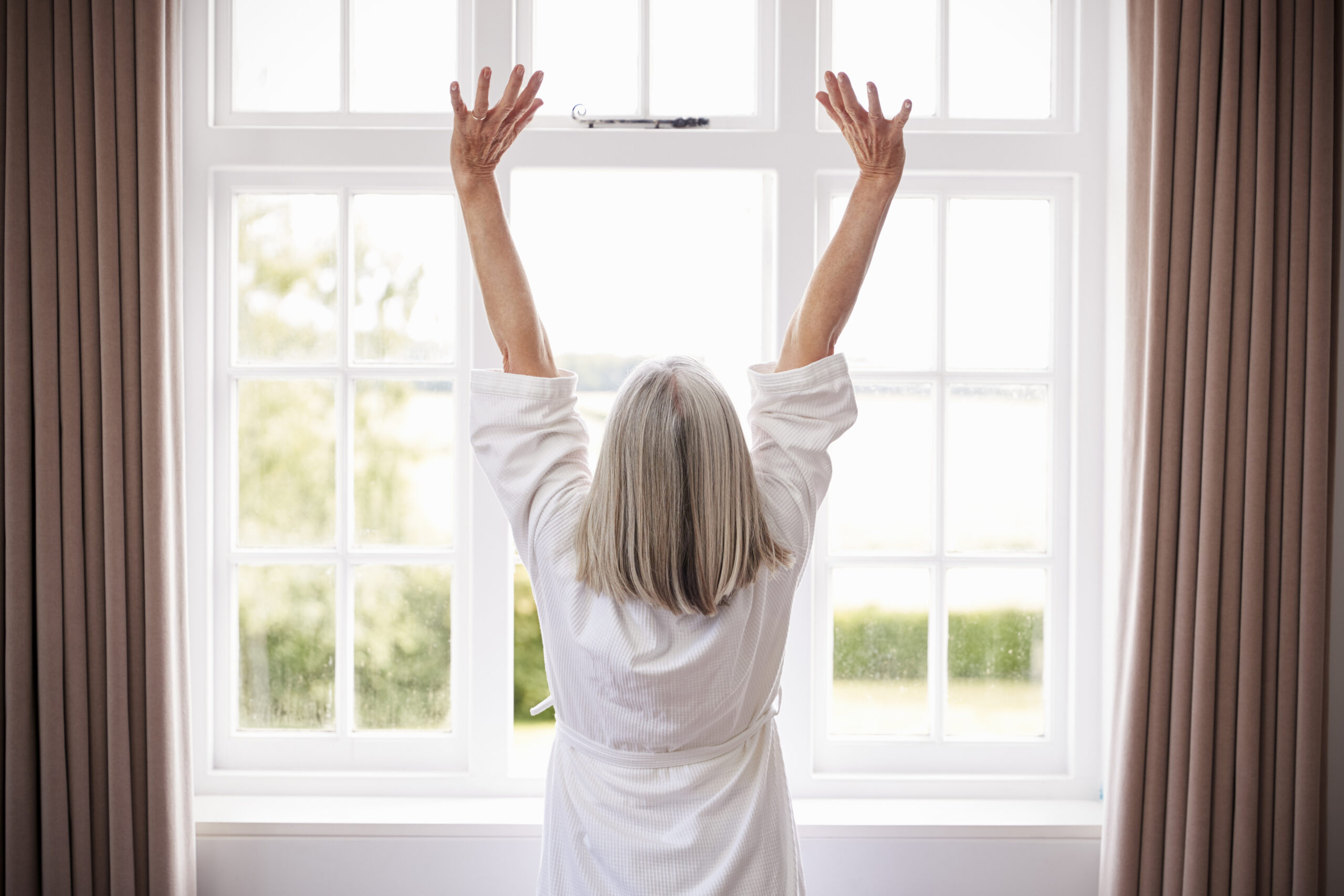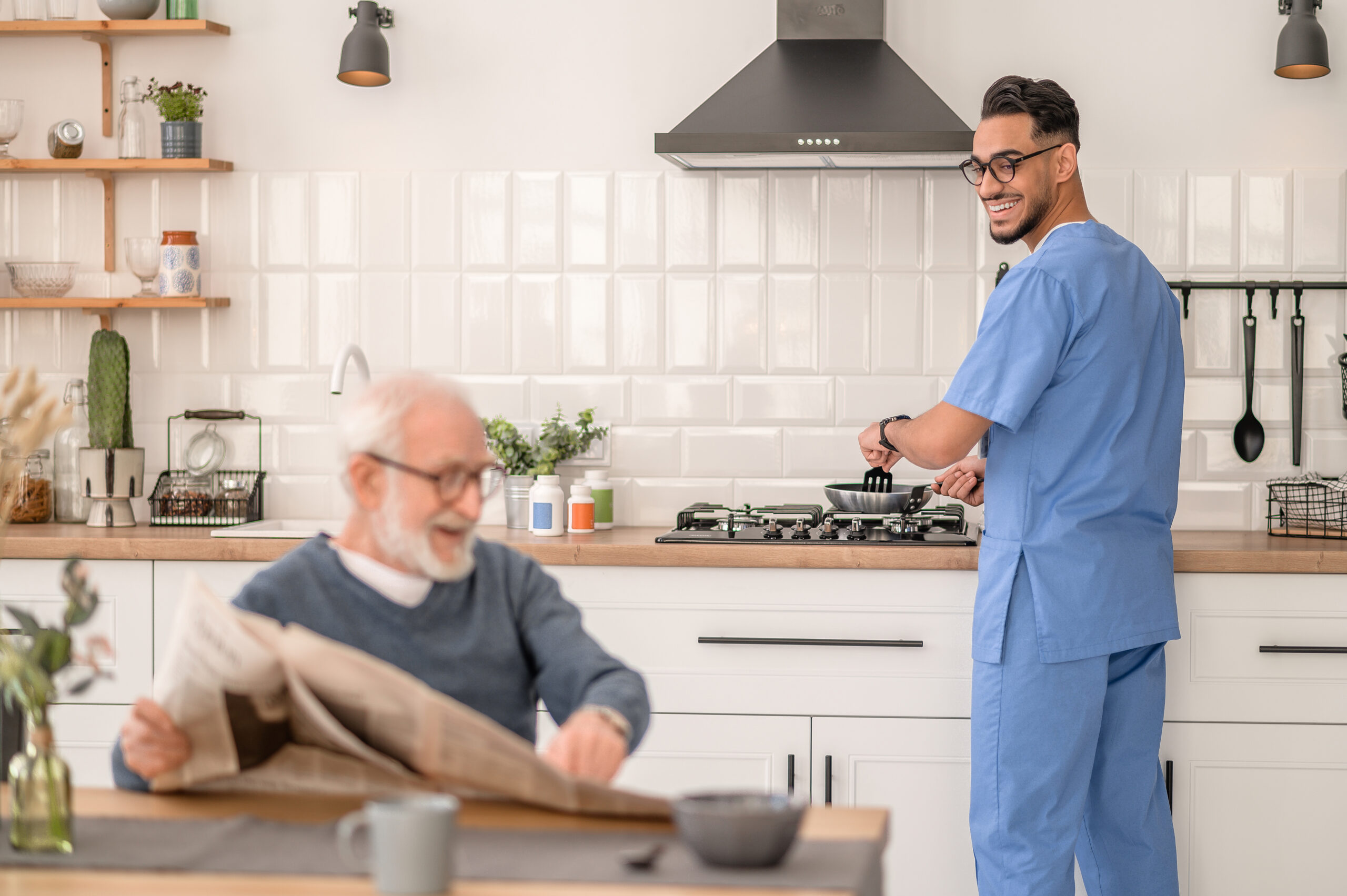
A day in the life of a live-in caregiver
Is a Live-in caregiver the right choice for your loved one?
One of the most common questions we get asked at Assured Quality Homecare is: ‘What do live-in caregivers actually do on a day-to-day basis?’
Maybe the best answer would be another question: What don’t they do?
After all, live-in care – that is, 24-hour care in the comfort of your loved one’s home – is about much more than just practical assistance. It’s about improving your loved ones lifestyle without asking them to change the way they like to do things and creating new opportunities that might otherwise have been out of reach.
In short, their role and responsibilities depend on the person they’re looking after. No two clients – and no two days – are the same, and live-in caregivers know just how important it is to be flexible to shifting needs and circumstances.
At Assured Quality Homecare, we’d prefer to give you an in-depth look at the sort of tasks a live-in caregiver may carry out. So in this guide, we’ll walk you through a typical day in the life of the care recipient, from the moment they wake up to the moment they drift off.
Live-in care is an elderly support option in which a caregiver moves into a your loved ones home to provide round-the-clock assistance(when needed.)
The caregiver offers as much assistance in day-to-day life as someone needs, from providing a reassuring presence to taking a much more active role in their wellbeing. They might play a key role in domestic duties and personal care – notably grooming and bathing – as well as ensuring an older person. stays active and healthy.
But above all, they’re there to make them feel safe. Live-in caregivers are qualified professionals with the training required to spot when something’s not right, and they’ll always be on hand to offer their expertise when circumstances start to change.
Who is a live-in caregiver suitable for?
Live-in care is suitable for almost everyone, but it’s best suited for those with low- to mid-level needs. It’s a flexible option that works around your loved one’s schedule and requirements, and all in the comfort of their own home.
This kind of care is equally suitable as a short-term solution – perhaps after a stay in hospital – as it is for those with chronic conditions. It’s also a great way of looking after those with early to mid-stage dementia, though in the later stages a nursing home is likely to be a better choice.
The benefits of live-in care

- Upto 14 hours of constant care
- A flexible and personalized care solution
- Dedicated one-on-one support
- Ongoing and familiar companionship
- Continued independence in their own home
- Expert support for chronic conditions
Daybreak
Rise and shine! We all want to start the day well, but morning routines can be the first to drop off when things start to get a little tougher.
An ASQ approved live-in caregiver is there to make sure your loved one starts the day right. They’ll help them get up, washed and dressed – and, ultimately, start the day feeling positive in themselves.

8:00am: Getting up
After a long night in bed, a person may have a little difficulty first thing in the morning. But with a caregiver, it won’t take them long to find their feet.
The caregiver is there to offer any support that’s required, whatever that may look like. It may be that they need some medication or want help getting into their dressing gown. Or they may need support in getting to the bathroom – and even someone to tend to more personal needs.
If they have bowel or bladder issues, for example, a caregiver can provide discreet support to ensure the care recipient is clean and comfortable. This is crucial not only for self-confidence, but for health, too: urinary tract infections are one of the most common causes of hospital admission for elderly people, but can be avoided with adequate hygiene and dealing with dehydration effectively.
8:15am: Having a shower
For families with elderly relatives, bathroom safety is usually at the top of the list of concerns.
That’s understandable: there’s always the fear they’ll slip on a wet floor and have an accident, or scald themselves with hot water. But a caregiver’s role is to keep an eye on the situation, discover just how much help they need and know when they need to step in.
After all, bathing is a personal thing. Your senior may simply need help getting in and out of the bath, or want to wash themselves with a towel wrapped around them. Whatever they prefer, a caregiver is there to work around their wishes and create the most comfortable environment possible.
The bathroom: things to think about
- Handrails or a shower seat can provide additional support
- Lay non-slip mats to limit the risk of accidents
- A hand-held shower can provide more maneuverability
- Use liquid soap rather than a bar of soap, which may be a slip hazard
8:45am: Brushing teeth
When it comes to oral hygiene for the elderly, consistency is key – and a caregiver is there to make sure an older person brushes every morning and evening like clockwork.
They might simply need to give them a nudge every now and then, or – if they have trouble holding the toothbrush – take a more manual role and brush their teeth for them. In any case, it’s important they do: according to the American Dental Association, poor oral health can ruin the fit of dentures, causing ulcers and eating difficulties.
9:00am: Getting ready
Everyone likes to look their best, no matter what their age. Carers are on hand to help with getting dressed – a task which only gets more difficult for those with joint trouble – and give their hair a spruce.
Morning
9:30am: Taking medication
However, complex an older person’s medication needs, a caregiver makes sure they stick to a strict schedule.
Getting them to stick to a specific plan may be as simple as the odd reminder, or it may demand a little more imagination. Whatever the case may be, the caregiver is always around to build it into the care recipient’s routine – not to mention keep an eye on their behavior and condition.
They’ll also be able to keep the family fully informed, giving everyone an opportunity to adapt the care plan and respond to challenges as they arise.
In cases of dementia, this may be even more essential, as changes are inevitable, continuous and can be drastic between early stage and late stage.
10:00am: Housekeeping
Looking after a home takes a lot of hard work at any age. But for an elderly relative, this responsibility can become a burden.
That’s where a caregiver comes in: they’re able to offer everything from a little light assistance to taking on domestic chores such as hoovering or keeping on top of laundry.
So there may be general housekeeping that needs doing – floors to mop, beds to change and dishes to wash – or minor practical jobs to check in on – light bulbs to change, pets to feed or gardens to maintain. The caregiver can devote as much time as they need.
11:00am: A cup of tea/coffee and a chat

A caregiver is as much there to offer companionship as physical support. That’s why a cup of tea and a chat is sometimes just the trick.
At ASQ, we spend a lot of time and attention matching caregivers and clients who could develop a real rapport and a genuine friendship. We’ll find out what your loved one likes and what they don’t like, and the sort of person they’re after. And by getting all this right, we’ll make sure they have someone around they enjoy spending time with.
In short, even a senior person’s downtime becomes something that keeps their mind engaged and a sense of isolation at bay. Just a cup of tea and chat can make all the difference – especially for those with dementia, for whom a catch-up can act as a powerful antidote to memory loss.
12:00pm: Meeting friends
When an elderly person invites a caregiver into their life, they’re still able to live the same life they always have done. Now, though, it’s easier than ever for them to get out and about.
With fewer complications getting to and from events outside of the home, they’ll find they’re able to stay connected to their social circle. This can prove crucial when it comes to their wellbeing: the more they can maintain those relationships that have underscored their lives to date, the more secure in their identity they’re likely to feel.
Afternoon
2:00pm: Getting some exercise

Physical activity can be one of the first things to drop off as we get older, but it’s also one of the most important parts of day-to-day life.
A caregiver will make exercises an intrinsic part of a senior’s routine, whether those are chair exercises or a gentle walk to the shops.
Frequent exercise is great for morale and offers significant health benefits. Research has shown regular movement has a positive effect on mental acuity and strengthens bone and joint health to improve overall mobility.
2:30pm: Firing up the gray matter
Vitality is linked to more than just the body – the mind is important, too.

Recent studies have suggested that both, when worked in tandem, provide the best possible health and wellbeing benefits. So once the client has had their fill of physical exercise, the caregiver might suggest puzzles, board games or crosswords to keep their mind ticking over.
Anything with a problem-solving element to it will do. After all, research has shown that mental training in old age can help boost intellectual power, maintain mental functions and, in some cases, slow or reverse memory decline.
3:30pm: Catching up with family

Technology is a wonderful thing, and it can play a big role in bridging the gap between an elderly relative and their family.
A caregiver might introduce the person they’re supporting to video messaging platforms such as Skype, or social media networks including Twitter and Facebook. These are great ways to stay in touch with one another and eliminate any geographical distance that stands in the way. Being able to share photos and memories online can help older people feel a part of the events they may otherwise not be able to experience firsthand.
5:30pm: Reminiscence
Reminiscence is an activity where those suffering from memory loss discuss their lives in order to better recall the past. In many cases, it involves the use of cues: old photos, films or a particularly meaningful piece of music.
Reminiscence has become an increasingly high-profile tool in dementia care over the past decade or so, and a caregiver has both the time and personal connection to be able to host regular reminiscence activities. The caregiver can also take their senior to events or groups to go down memory lane.
Evening
6:00pm: Dealing with “sundowning”
If an older person is struggling with dementia, the late afternoon and early evening can be a troubling period.
They may start to get anxious, agitated or confused when it starts to go dark outside. Two thirds of people with Alzheimer’s are reported to experience this pattern of restlessness, commonly known as “sundowning”.
A caregiver is on hand to offer their support until it passes, and to make sure they don’t do anything to injure themselves in the meantime. They may use a range of techniques to calm the situation down, from keeping their mind busy with another activity to something as simple as giving their hand a squeeze.
7:00pm: Preparing dinner

There’s nothing like a home-cooked meal at the end of a long day, and a caregiver is here to put together something that’ll be delightful.
Their first responsibility is to make something the client enjoys. That’s why the caregiver takes the time to get to know what they like and don’t like, and what they’re unable to eat for medical reasons. Our senses of taste and smell can change as we get older, and the caregiver can accommodate for this while keeping a close eye on salt and sugar intake.
The other responsibility is to make sure the person in their care maintains a balanced diet. This means shopping for foods that are good sources of calcium (dairy products, broccoli, tomatoes), vitamin D (fatty fish, eggs, cheese) and vitamin K (brussels sprouts, spinach, cabbage) – all of which are good for the bones and joints. Fiber (found in lentils, peas and beans) is also important to keep the bowels ticking over nicely.
Lack of hydration is a major problem among older people, who may experience a reduced sensation of thirst and forget to drink enough. This is likely to be more pronounced in those with Alzheimer’s disease or who have suffered a stroke.
Poor hydration can have a major impact on kidney function and cognitive ability and can lead to long-term health problems. The caregiver makes sure things don’t get to this stage, as well as offers the sort of personal support – notably for incontinence – which can embarrass the elderly into limiting their fluid intake.
9:00pm: Getting ready for bed
After a long day, it’s important to get a good night’s rest – but those can be harder to come by in later life as sleep problems in the elderly are common.
It’s up to the caregiver to put in place the sort of routine that’ll make it easy. They’ll get the person they’re caring for to bed at the same time every night and help them change into their nightwear and brush their teeth. They might prepare them a warm drink or a hot water bottle, or simply leave them to a spot of reading. Developing this consistency is simple, but it can prove fundamental in ensuring a healthy, happy lifestyle in the long term.
How Assured Quality Homecare can help
If you’re looking for care for a loved one, ASQ-approved caregivers offer round-the-clock support you can trust, tailored to the person they’re caring for.
We’re one of Connecticut’s leading live-in care providers, bringing the highest standard of care into your loved one’s home. With us, you can relax in the knowledge that those most important to you are well looked after, both practically and emotionally, and empowered to live an independent and fulfilling lifestyle.
We believe great care starts with great relationships. That’s why we make sure we match your loved one with the right person for them. We’ll work with you to find out more about their daily routine, as well as what they’re looking for in a caregiver, and handpick someone we think is perfect for your family.
To find out if live-in care is right for your loved one, you can arrange a complimentary assessment with our care navigator. Get in touch on 860-373-0428, and they’ll be happy to offer advice on how best to meet your unique needs.
If you decide you’d like to take advantage of live-in care, we’ll work with you to create a care plan that suits your loved one’s needs and wishes. Remember, we’re right by your side on every step of your care journey.
Leave a reply